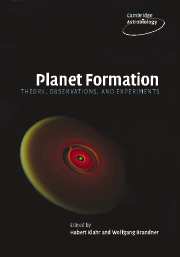Book contents
- Frontmatter
- Contents
- Preface
- Acknowledgments
- 1 Historical notes on planet formation
- 2 The Formation and Evolution of Planetary Systems: placing our Solar System in context
- 3 Destruction of protoplanetary disks by photoevaporation
- 4 Turbulence in protoplanetary accretion disks: driving mechanisms and role in planet formation
- 5 The origin of solids in the early Solar System
- 6 Experiments on planetesimal formation
- 7 Dust coagulation in protoplanetary disks
- 8 The accretion of giant planet cores
- 9 Planetary transits: a first direct vision of extrasolar planets
- 10 The core accretion–gas capture model for gas-giant planet formation
- 11 Properties of exoplanets: a Doppler study of 1330 stars
- 12 Giant-planet formation: theories meet observations
- 13 From hot Jupiters to hot Neptunes … and below
- 14 Disk–planet interaction and migration
- 15 The brown dwarf–planet relation
- 16 Exoplanet detection techniques – from astronomy to astrobiology
- 17 Overview and prospective in theory and observation of planet formation
- References
- Index
8 - The accretion of giant planet cores
Published online by Cambridge University Press: 14 September 2009
- Frontmatter
- Contents
- Preface
- Acknowledgments
- 1 Historical notes on planet formation
- 2 The Formation and Evolution of Planetary Systems: placing our Solar System in context
- 3 Destruction of protoplanetary disks by photoevaporation
- 4 Turbulence in protoplanetary accretion disks: driving mechanisms and role in planet formation
- 5 The origin of solids in the early Solar System
- 6 Experiments on planetesimal formation
- 7 Dust coagulation in protoplanetary disks
- 8 The accretion of giant planet cores
- 9 Planetary transits: a first direct vision of extrasolar planets
- 10 The core accretion–gas capture model for gas-giant planet formation
- 11 Properties of exoplanets: a Doppler study of 1330 stars
- 12 Giant-planet formation: theories meet observations
- 13 From hot Jupiters to hot Neptunes … and below
- 14 Disk–planet interaction and migration
- 15 The brown dwarf–planet relation
- 16 Exoplanet detection techniques – from astronomy to astrobiology
- 17 Overview and prospective in theory and observation of planet formation
- References
- Index
Summary
Introduction
The count of extrasolar giant planets detected by radial velocity measurements is now well over a hundred, accounting for about 5% of F, G and K main-sequence stars in the Solar neighborhood; about 10% of the planets are in multiple systems. It thus seems an inescapable conclusion that giant planet formation is a ubiquitous and robust process. There is also strong observational evidence for a correlation between the occurrence rate of (detectable) planets and the metallicity of the parent star (Gonzalez, 1997; Fischer and Valenti, 2003). There are two possible explanations for this phenomenon: first, the planet formation process may tend to “pollute” the parent star with higher-metallicity material, as giant planets (Laughlin and Adams, 1997) or planetesimals (Murray et al., 2001) migrate in and are engulfed. If this is the case, higher-mass stars, which have thinner convective envelopes in which to preserve the pollution, ought to display a systematically higher metallicity. However, no such trend has been observed so far (Wilden et al., 2002; Dotter and Chaboyer, 2002; Quillen, 2002; Fischer and Valenti, 2003). Furthermore, Fischer and Valenti (2005) found no sign of various other potential accretion signatures, such as dilution of metallicity in subgiants with planets. The other explanation is that higher metallicity – and thus a higher fraction of solids in the protoplanetary disk – increases the chances of forming a giant planet.
- Type
- Chapter
- Information
- Planet FormationTheory, Observations, and Experiments, pp. 129 - 146Publisher: Cambridge University PressPrint publication year: 2006
- 6
- Cited by



